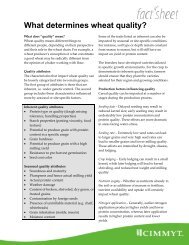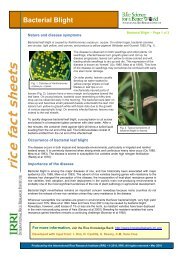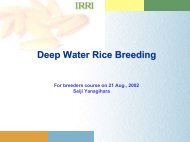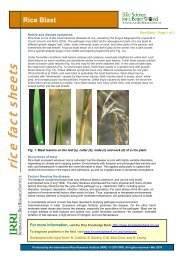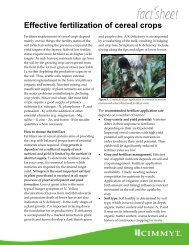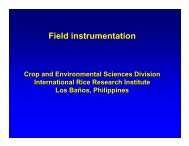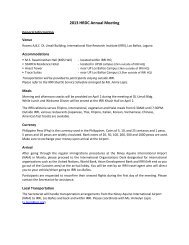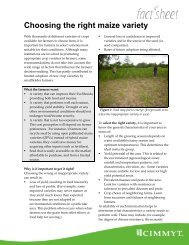International Standards' Organization â Rice Specification [ISO 7301]
International Standards' Organization â Rice Specification [ISO 7301]
International Standards' Organization â Rice Specification [ISO 7301]
You also want an ePaper? Increase the reach of your titles
YUMPU automatically turns print PDFs into web optimized ePapers that Google loves.
<strong>International</strong> Standards’ <strong>Organization</strong> – <strong>Rice</strong> <strong>Specification</strong> [<strong>ISO</strong> <strong>7301</strong>]<br />
1. Scope<br />
This <strong>International</strong> Standard lays down the minimum specifications for rice (Oryza sativa<br />
L.) of the following types: husked rice, husked parboiled rice, milled rice and milled<br />
parboiled rice, suitable for human consumption, directly or after reconditioning, and<br />
which is the subject of international trade.<br />
2. Normative references<br />
The following standards contain provisions, which, through reference in this text,<br />
constitute provisions of this <strong>International</strong> Standard. At the time of publication, the<br />
editions indicated were valid. All standards are subject to revision, and parties to<br />
agreements based on this <strong>International</strong> Standard are encouraged to investigate the<br />
possibility of applying the most recent editions of the standards listed below. Members<br />
of IEC and <strong>ISO</strong> maintain registers of currently valid <strong>International</strong> Standards.<br />
<strong>ISO</strong> 712: 1985, Cereals and cereal products – Determination of moisture content<br />
(Routine reference method).<br />
<strong>ISO</strong> 950: 1979, Cereals – Sampling (as grain).<br />
3. Definitions<br />
For the purposes of this <strong>International</strong> Standard, the following definitions apply.<br />
3.1. paddy: paddy rice: rough rice: <strong>Rice</strong> retaining its husk after threshing.<br />
3.2. husked rice: cargo rice [ “brown rice” is sometimes used as a synonym]: Paddy<br />
from which the husk only has been removed.<br />
The processes of husking and handling, particularly of parboiled rice, may result in some<br />
loss of bran.<br />
3.3. milled rice: <strong>Rice</strong> obtained after milling which involves removing all or part of<br />
the bran and germ from the husked rice.<br />
It could further be classified into the following degrees of milling.<br />
a) undermilled rice: <strong>Rice</strong> obtained by milling husked rice but not to the degree<br />
necessary to meet the requirements of well-milled rice.<br />
b) well-milled rice: <strong>Rice</strong> obtained by milling husked rice in such a way that some of the<br />
germ, and all the external layers and most of the internal layers of the bran have been<br />
removed.
c) extra-well-milled rice: <strong>Rice</strong> obtained by milling husked rice in such a way that<br />
almost all the germ, and all the external layers and the largest part of the internal<br />
layers of the bran, and some of the endosperm, have been removed.<br />
3.4. parboiled rice: <strong>Rice</strong>, the starch of which has been fully gelatinized by soaking<br />
paddy or husked rice in water followed by a heat treatment and a drying process.<br />
3.5. glutinous rice: waxy rice: Special varieties of rice (Oryza sativa L. glutinosa)<br />
the kernels of which have a white and opaque appearance. The starch of<br />
glutinous rice consists almost entirely of amylopectin. It has a tendency to stick<br />
together after cooking.<br />
3.6. size of kernels, broken kernels and chips<br />
3.6.1. whole kernel: Kernel without any broken part.<br />
3.6.2. head rice: Kernel, the length of which is greater than or equal to three<br />
quarters of the average length of the corresponding whole kernel.<br />
3.6.3. large broken kernel: Fragment of kernel, the length of which is less than<br />
three-quarters but greater than one-half of the average length of the<br />
corresponding whole kernel.<br />
3.6.4. medium broken kernel: Fragment of kernel, the length of which is less<br />
than or equal to one-half but greater than one-quarter of the average length<br />
of the corresponding whole kernel.<br />
3.6.5. small broken kernel: Fragment of kernel, the length of which is less than<br />
or equal to one-quarter of the average length of the corresponding whole<br />
kernel but which does not pass through a metal sieve with round perforations<br />
1.4 mm in diameter.<br />
3.6.6. chip: Fragment of kernel which passes through a metal sieve with round<br />
perforations 1.4 mm in diameter.<br />
3.7. extraneous matter: Organic and inorganic components other than kernels of rice,<br />
whole or broken<br />
3.8. heat-damaged kernels: Kernels, whole or broken , that have changed their<br />
normal color as a result of heating. This category includes whole or broken<br />
kernels that are yellow due to alteration. Parboiled rice in a batch of nonparboiled<br />
rice is also included in this category.<br />
3.9. damaged kernels: Kernels, whole or broken, showing obvious deterioration due<br />
to moisture, pests, disease or other causes, but excluding heat-damaged kernels<br />
3.10. immature kernels: Kernels, whole or broken, which are unripe and/or<br />
underdeveloped.
3.11. chalky kernels: Kernels, whole or broken, except for glutinous rice, of which<br />
at least three-quarters of the surface has an opaque and floury appearance.<br />
3.12. red kernels: Kernels, whole or broken, having a re coloration covering more<br />
than one-quarter of their surface, but excluding heat-damaged kernels (3.8).<br />
3.13. red-streaked kernels: Kernels, whole or broken, with red streaks, the lengths<br />
of which are greater than or equal to one-half of that of the whole kernel, but<br />
where the surface covered by these red streaks is less than one-quarter of the total<br />
surface.<br />
3.14. pecks: Kernels, whole or broken, of parboiled rice of which more than onequarter<br />
of the surface is dark brown or black in color.<br />
3.15. other kinds of rice<br />
3.15.1 Paddy in husked rice, in husked parboiled rice, in milled rice and in<br />
milled parboiled rice.<br />
3.15.2 Husked rice in husked parboiled rice, in milled rice and in milled<br />
parboiled rice.<br />
3.15.3 Milled rice in husked parboiled rice and in milled parboiled rice.<br />
3.15.4 Glutinous in non-glutinous rice.<br />
4. <strong>Specification</strong><br />
4.1 General, organoleptic and health characteristics<br />
Kernels of rice, whether or not parboiled, husked or milled, and whether or not<br />
whole or broken, shall be sound, clean and free from foreign odors or odor which<br />
indicates deterioration.<br />
The levels of additives and pesticide residues and other contaminants shall not<br />
exceed the maximum limits permitted by the national regulations of the country<br />
of destination or, in their absence, by the joint FAO/WHO Commission of Codes<br />
Alimentarius.<br />
The presence of living insects, which are visible to the naked eye, is not<br />
permitted.<br />
4.2 Physical and chemical characteristics<br />
4.2.1 The moisture content, determined in accordance with <strong>ISO</strong> 712, shall be<br />
not greater than 15% (m/m)
Note: Lower moisture contents may be required for certain destinations<br />
depending on the climate, duration of transport and storage. For<br />
further details, see <strong>ISO</strong> 6322, parts 1, 2 and 3.<br />
4.2.2 The maximum contents of extraneous matter, defective kernels and other<br />
kinds of rice in husked and milled rice, whether or not parboiled, and<br />
determined in accordance with the method described in annex A, shall be<br />
not greater than the values specified in table 1.<br />
4.2.3 All commercial contracts should be clearly the total percentage of broken<br />
kernels permitted, classified according to the agreed categories, and the<br />
relative proportions of each category, and the total percentage of<br />
extraneous matter and of defective kernels, determined in accordance with<br />
the method described in Annex A.<br />
The proportion of chips shall not exceed 0.1%.<br />
Table 1<br />
Defect<br />
Extraneous matter<br />
a) organic<br />
b) inorganic<br />
Reference to<br />
the<br />
definition<br />
3.7<br />
Husked<br />
rice<br />
Milled rice<br />
(nonglutinous)<br />
Husked<br />
parboiled<br />
rice<br />
Milled<br />
parboiled<br />
rice<br />
1.5<br />
0.5<br />
0.5<br />
0.5<br />
1.5<br />
0.5<br />
0.5<br />
0.5<br />
Paddy 3.1 2.5 0.3 2.5 0.3<br />
Husked rice 3.2 - 1.0 - 1.0<br />
Milled rice 3.3 - - 2.0 2.0<br />
Heat-damaged kernels 3.8 4.0 3.0 8.0 6.0<br />
Damaged kernels 3.9 4.0 3.0 4.0 3.0<br />
Immature kernels 3.10 12.0 2.0 12.0 2.0<br />
Chalky kernels 3.11 11.0 11.0 - -<br />
Red kernels 3.12 12.0 4.0 12.0 4.0<br />
Red-streaked kernels 3.13 - 8.0 0 8.0<br />
Glutinous rice 3.5 1.0 1.0 1.0 1.0<br />
Pecks 3.14 - - 4.0 2.0<br />
After milling


![International Standards' Organization â Rice Specification [ISO 7301]](https://img.yumpu.com/36696862/1/500x640/international-standards-organization-a-rice-specification-iso-7301.jpg)


